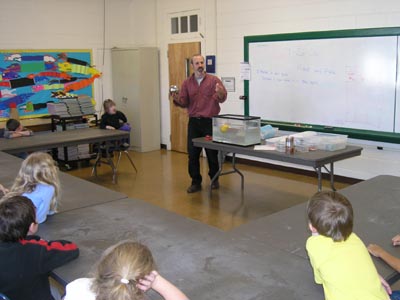
Demonstration

This assignment requires you to choose, plan, and practice a demonstration appropriate for elementary grades students and to present it language arts integration in an elementary classroom. The demonstrations should last 5-10 minutes. You may serve as assistants for one another, but each of you is responsible for writing and leading your own demonstration. Your goal is to arouse children's interest and get them thinking; focus more on asking good questions than on giving explanations. Be very careful you do not try to explain something you yourself do not understand.
There are MANY resources, both on-line and in the library, with good demonstrations to try. Here are some places to start:
- Robert Krampf's Happy Scientist site: Not only does this resource have excellent videos of demonstrations, but his explanations are generally excellent.
- The Exploratorium "Science Snacks" page: These demonstrations are written by the Exploratorium Science Museum in San Francisco. The site is organized by subject. Each demonstration has an image.
- Bizzarre Stuff You Can Make In Your Kitchen: A collection that includes some easy and fun demonstration, complete with images. The index is organized around the materials, such as Eggs: Stupid Egg Tricks.
- Experiments and Lecture Demos: A set of links to a variety of other sites from Ron Rinehart, Monterey Peninsula College.
You will be evaluated on both your written materials and your presentation itself.
Your written materials will be posted to AsULearn before you do your demonstration and should include:
As you plan, consider the following suggestions from Richard Black, in his article "Why Demonstrations Matter" (Science and Children, September 2005, pp. 52-55):
"--State the concepts in your lesson plan, but do not offer them to students before the demonstrations;
--Question students throughout the demonstration (Why do you think...?);
--Elicit predictions and hypotheses and encourage conclusion development. (What do you think will happen if...?);
--Include students in carrying out the demonstration, being part of the procedure, and assisting with material set-up; and
--Encourage active observation that includes diagramming, illustration, etc. Students may keep a journal or notebook and should enter "Problem, Materials, Diagrams, Predictions" (before the presentation is carried out)," and "Observations, Results, and Conclusions" (after understanding the principle or concept)."
You will need to record yourself teaching this demonstration. After you have taught, you should listen back to your lesson and write a 500-750 word reflection on your teaching. In particular, listen closely for the kinds of questions you asked and how you asked your questions. Also, note how the language arts connection worked.
Click here for the rubric by which you will be graded.
Click here for images from a previous class.